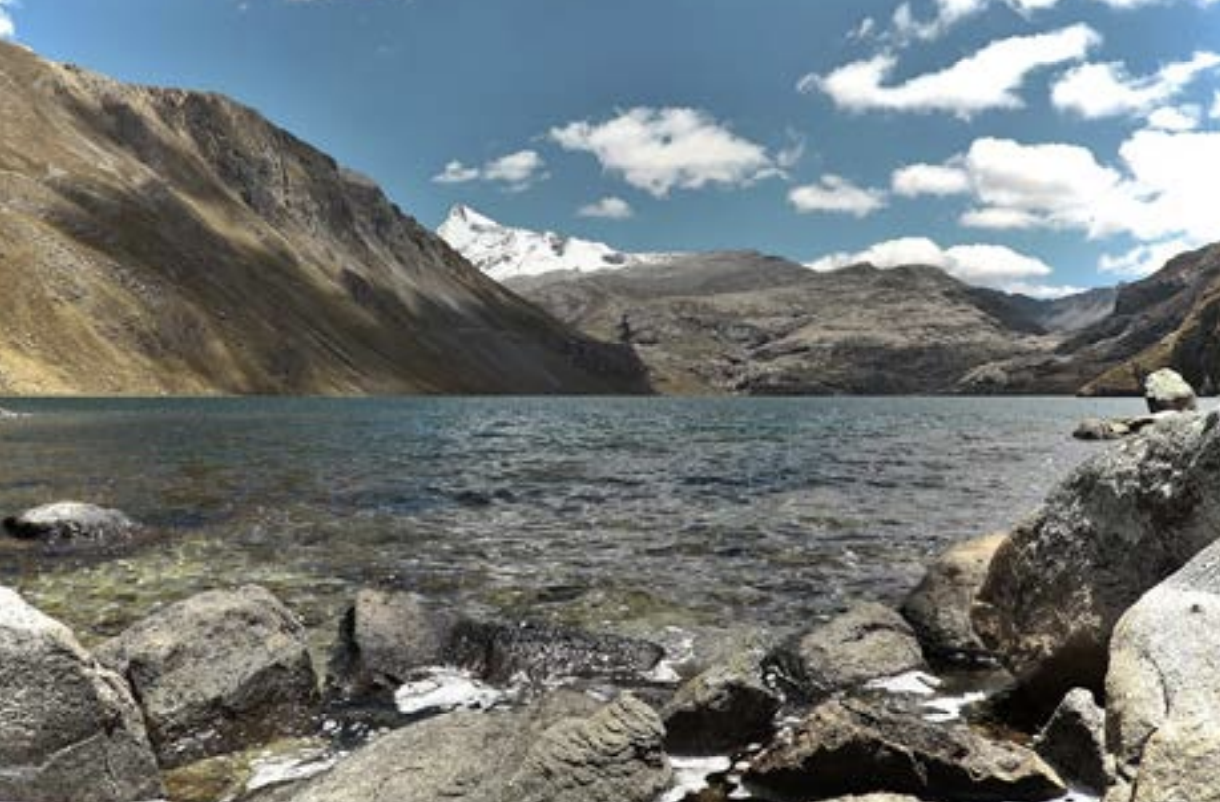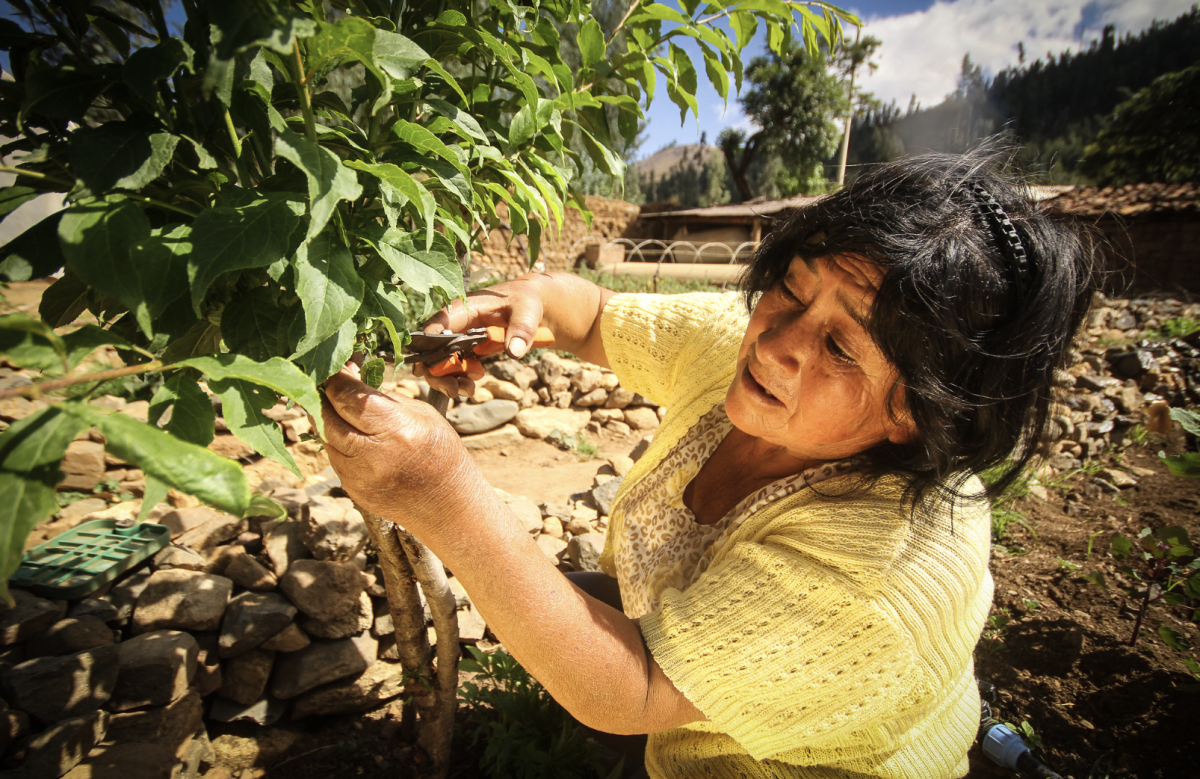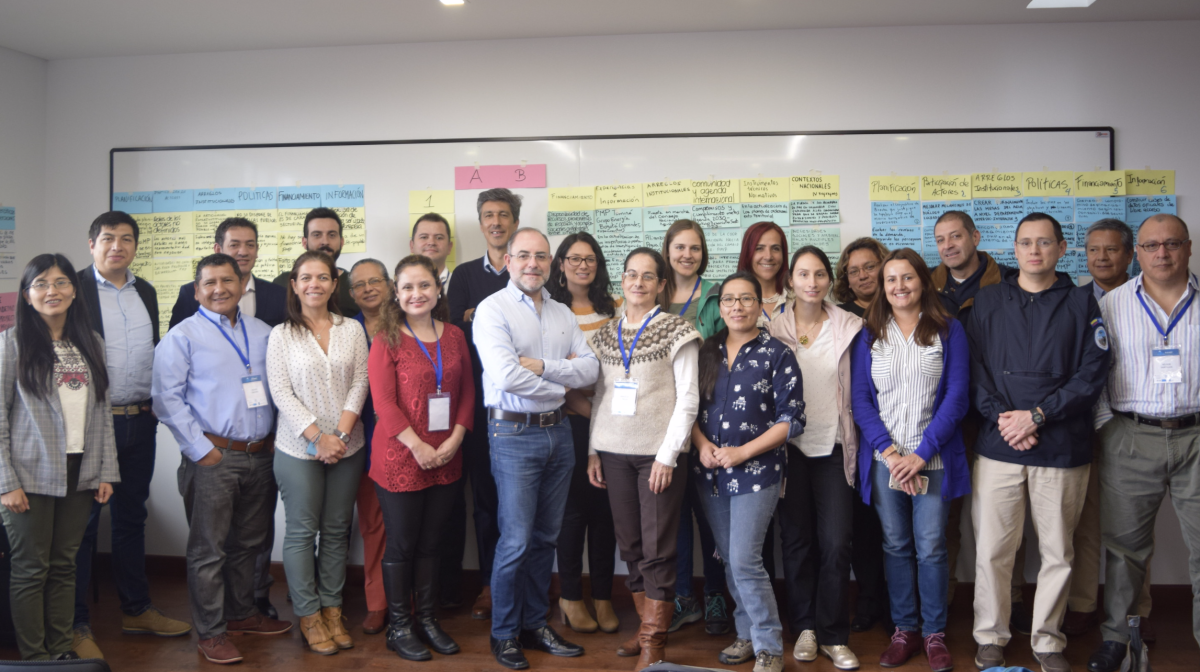Sustainable watershed management in glacial mountain ecosystems in Peru

Summary
The Glaciares+ project was led by NGO CARE Peru, in partnership with the University of Zurich and financed by the Swiss Cooperation for Development – SDC. This initiative focused on the implementation of adaptation and risk management measures in the regions of Ancash, Cusco, and Lima. It aimed to develop water resources management plans to sustainably manage more than 200 new lakes. Nature-based approaches were integral to these plans, with local stakeholders collaborating to restore freshwater ecosystems and implement sustainable farming methods. It also used community-based adaptation to integrate community knowledge into risk and water resources management, while strengthening governance by building collective management between the community, public, private, and academic institutions.
71% of the world’s tropical glaciers are found in Peru. Over the last 40 years, due to the impacts of climate change, the glacial surface of 18 snow-capped mountain ranges in the country has been reduced by 53%. The accelerated retreat of the glaciers often creates unstable lagoons and causes natural disasters such as alluvium landslides and deadly flash foods. Glacial melt is affecting both freshwater ecosystems and the flora and fauna that rely on them, as well as local communities who are exposed to an increased number of natural hazards, such as landslides and flash floods.
Overview
- Location:
- Implementation sites:
-
- Single country
- Multiple locations
- Mountain region:
-
Andes
- Province:
-
- Ancash, Cusco, and Lima
- Solution scale:
- Area Covered:
-
- 163 hectares
- Ecosystem type(s):
- Other Ecosystem type(s):
-
- Glacial
- Solution type(s):
- Sector(s):
- Climate impact(s) addressed:
- Climate impact time-scale(s):
- Main benefit associated with the solution:
- Co-benefit(s) associated with the solution implementation:
- Implementation timeline:
-
- 2011 - 2019
- Sendai targets:
-
Solution details
Main beneficiaries & outcomes
Climate risk reduction:
- Restored and better-managed water resources and glacier ecosystems have helped to reduce the risk of landslides and flash floods for more than 70,000 people living downstream.
- In addition, women, Indigenous People and poor communities, who led these nature-based solutions, now benefit from access to climate information services, helping to protect their lives and livelihoods from natural disasters.
Nature conservation and restoration:
- The project included the creation or strengthening of 34 water and sanitation service boards to sustainably manage natural and water resources.
- 143 hectares (ha) of wetland have been protected and restored.
- 11ha of springs have been protected.
- 200 new lakes have been created and sustainably managed.
- 30ha of water surface area have been restored in ten periglacial lagoons or rustic dams in high mountain areas. These are managed by communities and water and sanitation service boards to store water and recharge and maintain wetlands.
- The improved water supply has allowed new watering holes for wildlife to be created and mountain meadows to be restored.
People:
- Communities now have better access to water, improved income and strengthened capability and knowledge to manage climate change risks and water resources.
- Improved scientific knowledge, better public policies and local implementation skills also contribute to long-term poverty alleviation in Peru.
- 1,000 small-scale farmers have gained greater skills in climate adaption, disaster risk management and integrated management of water resources.
- 73 farmers have been trained in good agricultural practices that sustainably and efficiently use highland water resources such as the periglacial lagoons and micro water reservoirs (cochas).
- Four women-owned and operated companies have been created to sustainably produce and market products such as coffee, granadilla and honey.
- Public employees in regional and national entities have been trained to apply new capacities for glacial-related disaster risk management.
- Women’s access to public positions was promoted, such as their incorporation into the executive councils of organizations and in the Sanitation Services Administration Board (JASS) elections where women were elected. Directors of micro-watershed committees, JASS directors, and male and female leaders participated in the diagnosis and planning of Integrated Water Resources Management workshops to ensure the participation of women.
Nearly 70,000 people living downstream from the glaciers have benefitted from early warning systems for landslides.

Planning and implementation
The first phase of the project was carried out between November 2011 and August 2015. Its objective was to strengthen the technical-operational capacities in the monitoring and investigation of glaciers to bring scientific knowledge closer to the surrounding communities and provide information for their adaptation and reduction of vulnerability. Likewise, facilitate the institutional conditions that guarantee the sustainability of said actions within the framework of adaptation to climate change.
The second phase (2015-2019) aimed to build and strengthen capacities for adaptation to climate change and the reduction of risks associated with the retreat of the glacier while taking advantage of the opportunities for managing its water resources. A wide range of knowledge and capacities were exchanged and built in close collaboration with Peruvian partner institutions, government agencies, communities and local decision makers, as well as with a pool of international experts. In this process, leadership skills were developed in order to improve adaptation and management capacities in local communities. One important achievement was that a total of 69,804 vulnerable people situated in risk areas reduced their risk by applying participatory climate change adaptation measures. In addition, important networks of scientific collaboration were established, which is shown by a large number of new university and professional courses, leading to a total of 250 newly trained professionals. In addition, eight new Public Investment Projects with a total budget of 68.6 million Soles were implemented, which focus on the creation of major hydraulic infrastructure for multi-sectoral use in watersheds vulnerable to climate change.
Overall, the Glaciares+ project saw community-led, multi-stakeholder coalitions of scientists, public and private sector actors collaboratively develop water resources management plans to sustainably manage more than 200 new lakes. As part of those water resources management plans, communities working with other stakeholders have:
- Protected and restored wetland by replanting native species, protecting grassland and forests around important spring water resources, fencing tributaries for restoration of vegetation, and planting native species on water banks to protect water resources.
- They have also established sustainable communal grazing plans to prevent overgrazing.
The project also trained smallholder farmers to carry out sustainable farming practices including the sustainable use of water. These nature-based solutions (NbS) were combined with other measures: for example, building dams to harvest water from periglacial lagoons for the storage of rainwater and protection of wetlands, and the design and implementation of early disaster warning systems.

Finance
This project was financed by the Swiss Cooperation for Development – SDC (COSUDE). Total costs equated to CHF 19,000,000, with SDC’s contributions in Phase 1 CHF 4,961,986, Phase 2 CHF 5,000,000, and other estimated contributions totalling CHF 9,038,014.
Innovation
Glaciares+ was an innovative solution both in its thematic scope and process. From the beginning, an interdisciplinary approach was taken as scientific studies were developed on the health of Peru’s glaciers, their projected decline under different climate change scenarios, and the subsequent impact on downstream resources. In addition, socioeconomic and demographic studies were carried out in order to understand the risks communities in these areas already face, such as poverty and gender inequality, and then the program design considered how the impacts of glacial melt (e.g. landslides, flooding, availability of water resources) would exacerbate those underlying drivers of risk.
The program was also innovative in the ways in which community-level data was integrated with a scientific understanding of climate change risks in the area. An important aspect of the project was the participation and integration of the communities in participatory climate risk analysis through an approach known as Climate Vulnerability and Capacity Analysis. In this process, communities provide feedback on how climate change has already affected their livelihoods, ecosystems, governance, and the lives of women in particular. This analysis is then considered in the context of projected climate change effects, such as glacial melt, resulting in community disaster risk management and adaptation plans that are developed based on both community-level and academic analysis and planning.
The interventions funded through Glaciares+ were innovative in that they were conceived of at the landscape level, looking at ways in which landscape restoration in the Andes can improve water access and reduce landslides downstream while also incorporating solutions focused on poverty reduction. For example, smallholder farmers received training in climate smart agricultural practices that better conserved water and soil while increasing incomes and protecting the highland wetland areas that are crucial for capturing rainwater and glacial melt. In this way, the Glaciares+ interventions focused on maximising co-benefits between environmental protection, disaster risk reduction, climate adaptation, and increased capacities and livelihood opportunities for communities.
Long term project sustainability and maintenance
Glaciares+ long-term sustainability comes from its elements of capacity building and systems strengthening. Through Glaciares+, alliances have been forged between the Ministry of Environment, National Water Authority, General Secretary of Risk Management of Peru, and the Ministry of Economy and Finance, in addition to research institutions such as the University of Zurich and the University of Cusco. The operation and maintenance of interventions such as early warning systems for glacial landslides, the first of its kind in Peru, have been integrated into the priorities of these public and civil society partners. One of CARE’s primary roles was in ensuring connections between these system level actors and in harmonizing policies from the local to national level to create an enabling environment for the sustainability of the project interventions. Some examples of these systems level changes include:
- The Ministry of Economy and Finance adjusting its public investment system to prioritize alluvial risk management.
- The Ministry of Environment adjusting its management instruments to respond to national adaptation priorities.
- The Presidency of the Council of Ministers adjusting its national risk management instruments and their coordination between ministries for technical and budgetary issues.
- Capacity building among local and regional governments so their management system and instruments respond to climate risk issues
- Educational Management Units at the local and regional level incorporated risk management and climate change adaptation approaches into school curricula at the regional level.
- The National Service of Natural Areas Protected by the State (SERNANP) incorporated the project’s technical studies and the mapping of glacial hazards into the zoning and management of their master plans.
- Through participation in climate risk analyses and adaptation planning, participation in water management boards, training in climate smart agriculture and wetland restoration practices, and participation in the creation of early warning systems for glacial-related disasters, communities increased their knowledge and skills in climate adaptive practices as well as their competencies in engaging with public authorities to ensure their needs are being met in local, regional, and national adaptation plans.
Capacities for design and implementation
Knowledge
Combining scientific knowledge with traditional knowledge helped to ensure that the design of the NbS solutions incorporated both local indigenous knowledge and robust scientific data. Combining science with local knowledge of flood risks also led to the creation of an early warning system for floods through the community mapping of flood-prone areas and evacuation routes. This system also helps communities and researchers collect and monitor data in the long term to inform the design of appropriate NbS and other measures to adapt to climate change impacts.
Political / Legal
Strengthening of capabilities at the three levels of government (national, regional and local) and in academia has raised awareness of the importance of glaciers and the integrated management of water resources for political actors. Likewise, it has allowed dialogue and the exchange of knowledge between the scientific community and the public sector and increased the integration of scientific information into development plans, strategies, methodological tools and investment projects, such as in the use of flooding and landslide hazard risk maps.
In addition, scientific information on the effects of climate change on glaciers and other natural resources has been incorporated into territorial development plans, led to the creation of the National Institute of Glaciers and Mountain Ecosystems, helped in the formulation of the multipurpose public investment projects for environmental protection and management, and allowed for the integration of community-based adaptation, disaster risk reduction, and integrated water resources management approaches in development plans agreed at the regional level.
Institutional
This solution involved a multi-stakeholder partnership: Close collaboration amongst communities, researchers and government officials has strengthened collective management of resources and climate risks. Scientific and local knowledge on NbS is now integrated into government development plans, strategies, and investments. This has led to increased public and private investment in sustainable water resources management. Increased monitoring capacity supported by the government of Peru enables more data to be used by researchers to inform the design of NbS and other measures, creating a virtuous cycle of long-term planning and implementation.
Socio-cultural
This project took a community-based adaptation approach, combining traditional knowledge with innovative strategies to address current vulnerability, while strengthening adaptive capacity to face new dynamic challenges. In particular, it focused on engaging women in natural resource management. Women are more aware of natural resource distribution and long-term risks and often bear most responsibility for securing long-term access to water for their families. By supporting women to be more active in communal decision making, communities are more likely to monitor and assess long-term risks and manage their natural resources sustainably for long-term benefits.
Outlook & Scalability
Barriers and adverse effects
Some barriers include:
- CARE Peru’s implementation structure at the local level, due to the complexity of its work, required a broader executing team with more varied capacities, bearing in mind its inter-institutional coordination
- More active governance of the project itself was needed; there was a steering committee, although not all the actors initially identified participated
- Lack of participation of key stakeholders throughout all stages of the project cycle. Turnover and staffing changes among public sector partners meant that many stakeholders who were involved in the design process were not present for monitoring and evaluation, similarly actors who were involved in later stages of the project cycle were not present for the design stage.
- A lack of existing adequate evaluations of the social and political situation of the intervention areas contributed to the delay of the project.
- Baseline and monitoring assessments faced delays due to difficulties in coordination between multi-sectoral partners.
- There needed to be clarity in the development of project indicators and monitoring after the baseline evaluation, in addition to more efficient monitoring of implementation progress, which made it difficult to present project results accurately.
- Because many of these multi-sectoral, landscape-level approaches were novel in Peru and did not have pre-existing institutional support and capacities, extra time and resources had to be spent in justifying the purpose of the project, developing connections between partners, and formulating policies and procedures among partners that were necessary to support the implementation and maintenance of interventions such as water management boards and early warning systems.
- Securing long-term investment for public projects amid political and social turmoil.
Transformation and future outlook
This solution combined NbS and grey infrastructure to meet a diverse set of short-term and long-term needs: As glaciers continue to retreat at a fast rate, NbS alone are not enough to sustainably manage water resources in a way that can meet the increasing demands for human consumption while preventing further loss of crucial habitats like wetlands. Combining the restoration of native vegetations and sustainable use of natural resources in key watersheds with grey infrastructure such as dams can help ensure long-term sustainable management of water resources while meeting immediate needs for irrigation, fishing and energy generation. This type of hybrid management can meet and balance water needs and generate broader stakeholder support for NbS. The NbS contributed to the adaptive capacity of the communities and utilised gender-sensitive CVCA methodology to identify adaptation measures aligned with Peru’s NDC.
Potential for upscaling and replication
Glaciares+ has built capacities for climate adaptation among public, civil society, and community partners, helping to integrate adaptation priorities into the budgets, policies, and procedures of numerous ministries from the local to national scale. This capacity building and policy formulation creates an enabling environment for scaling and replication in other geographies in Peru, which is also aided by numerous national and international fora that Glaciares+ has participated in, such as workshops carried out in Andean regions in Colombia and Chile where learning related to climate adaptation and glacial melt management were shared between partners. The second phase of Glaciares+ also focused on identifying investment sources and mechanisms to replicate adaptation and disaster risk management measures in public and private investment systems or in alliances.
- Restoring ancient water management systems in the high Andes as an adaptation to climate change – Miraflores, Peru
- Restoring, conserving and expanding mountain pastures and wetlands and improving communal management in Canchayllo, Peru
- Strengthening and sustainable development of quinoa cultivation in the province of Anta
- Mechanisms for ecosystem services retribution in the Cañete river basin, Peru (MERESE)
- Improvement of 3 irrigation channels incorporating climate change adaptation measures in Andean ecosystems
- Proyecto Glaciares+



Comments
There is no content